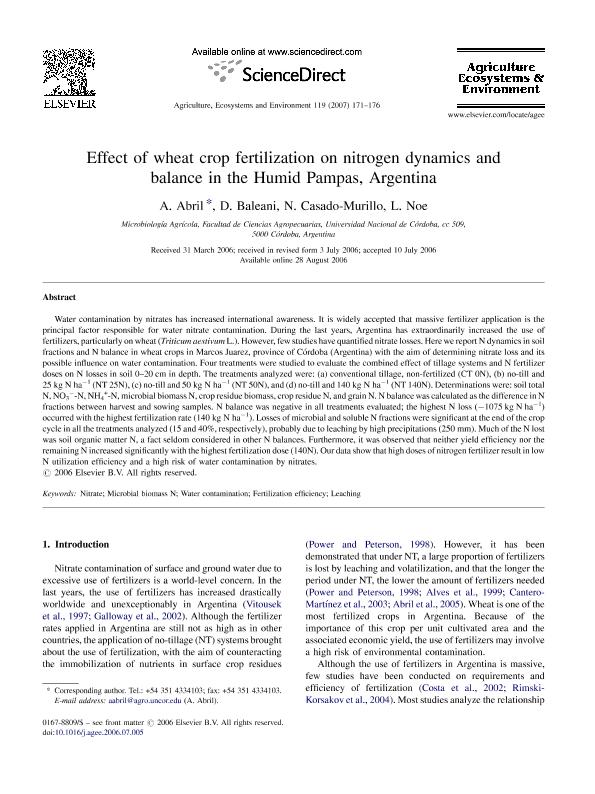Mostrar el registro sencillo del ítem
dc.contributor.author
Abril, Adriana

dc.contributor.author
Baleani, D.
dc.contributor.author
Casado Murillo, N.
dc.contributor.author
Noe, Laura Belén

dc.date.available
2019-08-01T22:57:53Z
dc.date.issued
2007-02
dc.identifier.citation
Abril, Adriana; Baleani, D.; Casado Murillo, N.; Noe, Laura Belén; Effect of wheat crop fertilization on nitrogen dynamics and balance in the Humid Pampas, Argentina; Elsevier Science; Agriculture, Ecosystems and Environment; 119; 1-2; 2-2007; 171-176
dc.identifier.issn
0167-8809
dc.identifier.uri
http://hdl.handle.net/11336/80783
dc.description.abstract
Water contamination by nitrates has increased international awareness. It is widely accepted that massive fertilizer application is the principal factor responsible for water nitrate contamination. During the last years, Argentina has extraordinarily increased the use of fertilizers, particularly on wheat (Triticum aestivum L.). However, few studies have quantified nitrate losses. Here we report N dynamics in soil fractions and N balance in wheat crops in Marcos Juarez, province of Córdoba (Argentina) with the aim of determining nitrate loss and its possible influence on water contamination. Four treatments were studied to evaluate the combined effect of tillage systems and N fertilizer doses on N losses in soil 0-20 cm in depth. The treatments analyzed were: (a) conventional tillage, non-fertilized (CT 0N), (b) no-till and 25 kg N ha-1 (NT 25N), (c) no-till and 50 kg N ha-1 (NT 50N), and (d) no-till and 140 kg N ha-1 (NT 140N). Determinations were: soil total N, NO3--N, NH4+-N, microbial biomass N, crop residue biomass, crop residue N, and grain N. N balance was calculated as the difference in N fractions between harvest and sowing samples. N balance was negative in all treatments evaluated; the highest N loss (-1075 kg N ha-1) occurred with the highest fertilization rate (140 kg N ha-1). Losses of microbial and soluble N fractions were significant at the end of the crop cycle in all the treatments analyzed (15 and 40%, respectively), probably due to leaching by high precipitations (250 mm). Much of the N lost was soil organic matter N, a fact seldom considered in other N balances. Furthermore, it was observed that neither yield efficiency nor the remaining N increased significantly with the highest fertilization dose (140N). Our data show that high doses of nitrogen fertilizer result in low N utilization efficiency and a high risk of water contamination by nitrates.
dc.format
application/pdf
dc.language.iso
eng
dc.publisher
Elsevier Science

dc.rights
info:eu-repo/semantics/openAccess
dc.rights.uri
https://creativecommons.org/licenses/by-nc-sa/2.5/ar/
dc.subject
Fertilization Efficiency
dc.subject
Leaching
dc.subject
Microbial Biomass N
dc.subject
Nitrate
dc.subject
Water Contamination
dc.subject.classification
Agricultura

dc.subject.classification
Agricultura, Silvicultura y Pesca

dc.subject.classification
CIENCIAS AGRÍCOLAS

dc.title
Effect of wheat crop fertilization on nitrogen dynamics and balance in the Humid Pampas, Argentina
dc.type
info:eu-repo/semantics/article
dc.type
info:ar-repo/semantics/artículo
dc.type
info:eu-repo/semantics/publishedVersion
dc.date.updated
2019-08-01T13:41:11Z
dc.journal.volume
119
dc.journal.number
1-2
dc.journal.pagination
171-176
dc.journal.pais
Países Bajos

dc.journal.ciudad
Amsterdam
dc.description.fil
Fil: Abril, Adriana. Universidad Nacional de Córdoba. Facultad de Ciencias Agropecuarias. Departamento de Recursos Naturales. Cátedra de Microbiología Agrícola; Argentina
dc.description.fil
Fil: Baleani, D.. Universidad Nacional de Córdoba. Facultad de Ciencias Agropecuarias. Departamento de Recursos Naturales. Cátedra de Microbiología Agrícola; Argentina
dc.description.fil
Fil: Casado Murillo, N.. Universidad Nacional de Córdoba. Facultad de Ciencias Agropecuarias. Departamento de Recursos Naturales. Cátedra de Microbiología Agrícola; Argentina
dc.description.fil
Fil: Noe, Laura Belén. Consejo Nacional de Investigaciones Científicas y Técnicas; Argentina. Universidad Nacional de Córdoba. Facultad de Ciencias Agropecuarias. Departamento de Recursos Naturales. Cátedra de Microbiología Agrícola; Argentina
dc.journal.title
Agriculture, Ecosystems and Environment

dc.relation.alternativeid
info:eu-repo/semantics/altIdentifier/url/https://www.sciencedirect.com/science/article/pii/S016788090600274X
dc.relation.alternativeid
info:eu-repo/semantics/altIdentifier/doi/https://doi.org/10.1016/j.agee.2006.07.005
Archivos asociados
